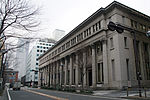SBI Graduate School
2008 establishments in JapanEducational institutions established in 2008Kantō university stubsPrivate universities and colleges in JapanSoftBank Group ... and 2 more
Universities and colleges in Kanagawa PrefectureUniversities and colleges in Yokohama
SBI Graduate School (SBI大学院大学, esubiai daigaku-in daigaku) is a private distance learning university (for graduate studies) in Yokohama, Kanagawa, Japan. It was established in 2008 as part of SBI Group, a financial services company.
Excerpt from the Wikipedia article SBI Graduate School (License: CC BY-SA 3.0, Authors).SBI Graduate School
Yokohama Naka Ward
Geographical coordinates (GPS) Address Nearby Places Show on map
Geographical coordinates (GPS)
| Latitude | Longitude |
|---|---|
| N 35.447207 ° | E 139.638819 ° |
Address
横浜メディア・ビジネスセンター
231-0011 Yokohama, Naka Ward
Japan
Open on Google Maps










